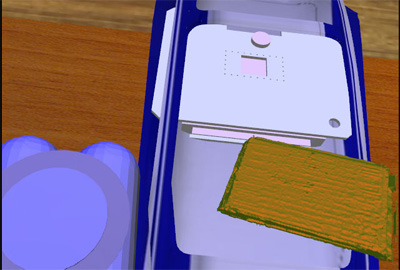Mixed Environment for Review and Generation of Engineering Design (MERGED)

Overview
VIRTUAL EXPERIENCES RESEARCH GROUP
about us . projects . people . meetings
Mixed Environment for Review and Generation of Engineering Design (MERGED)

Overview
Engineering design and evaluation has been a traditional application target for virtual environments (VEs). However, successes are still limited, with few systems in actual use. This is due primarily to the difficulty in simulating engineering design and assembly verification tasks at a high degree of fidelity. Instead of an entirely virtual environment, engineering design tasks need a Mixed Environment (ME), a combination of a few real objects with many virtual objects. Our ME system employs a pipeline to rapidly incorporate real objects and develops a means for multiple parties to view and interact with the proposed designs. Challenge We have partnered with NASA engineers at NASA Langley Research Center to obtain content and end-user feedback of our ME system. In payload assembly, integration is a crucial stage in which devices are connected with cables, parts, and tools. Integration issues such as Subsystem layout challenge NASA engineers. Mixed Environments provides a tool that can effectively simulate integration, accommodates real-time modifications, provides haptic feedback with a “real-world” look and feel, allows for extemporaneous inclusion of tools and other objects, and supports simultaneous use by multiple users. Such a tool would aid in assembly and layout modification.
Approach 
• Create virtual representations of the real objects involved in the assembly plan.
• Track the real objects such that the corresponding virtual representations mimic their motion and articulation.
• Insert the virtual representation in the ME, such that they are active participants in simulations.We have developed a pipeline to accomplish:
• Capture real object shape using a 3D laser scanner.
• Aligned, merged, and hole-filled scans to create a complete model of the object.
• Attach colored markers both to the real object and, in software, to corresponding positions on the virtual model.
• Place colored markers on a simple object which will allow the user to manipulate the complex CAD model in the ME.
Team Members
Benjamin Lok, PhD
Xiyong Wang, Graduate Student
John Quarles, Graduate Student
Aaron Kotranza, Graduate Student
Selected Publications
Kotranza A., Quarles J., Lok B. "Mixed Reality: Are Two Hands Better Than One?" To Appear in Proceedings of the ACM Symposium on Virtual Reality Software and Technology, 2006. Limassol, Cyprus, November 1-3, 2006.
pdf slidesWang, Xiyong, Aaron Kotranza, John Quarles, Benjamin Lok, and Danette Allen (2005). “A Pipeline for Rapidly Incorporating Real Objects into a Mixed Environment,” Proceedings of Fourth IEEE and ACM International Symposium on Mixed and Augmented Reality, 5-8 Oct. 2005 Vienna, Austria. Pages 170~173. pdf slides
Wang, Xiyong, Aaron Kotranza, John Quarles, Benjamin Lok, and Danette Allen (2005). “Enhanced Hybrid Environment---A System for Team-Based Evaluation of Engineering Designs,” UF CISE Tech Report 04- 012.

